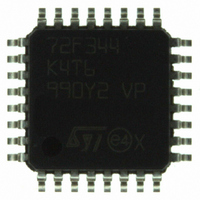ST72F344K4T6 STMicroelectronics, ST72F344K4T6 Datasheet - Page 119

ST72F344K4T6
Manufacturer Part Number
ST72F344K4T6
Description
MCU 8BIT 16KB FLASH MEM 32-LQFP
Manufacturer
STMicroelectronics
Series
ST7r
Datasheet
1.ST72F344K2T6.pdf
(247 pages)
Specifications of ST72F344K4T6
Core Processor
ST7
Core Size
8-Bit
Speed
8MHz
Connectivity
I²C, LIN, SCI, SPI
Peripherals
LVD, POR, PWM, WDT
Number Of I /o
24
Program Memory Size
16KB (16K x 8)
Program Memory Type
FLASH
Eeprom Size
256 x 8
Ram Size
1K x 8
Voltage - Supply (vcc/vdd)
2.7 V ~ 5.5 V
Data Converters
A/D 12x10b
Oscillator Type
Internal
Operating Temperature
-40°C ~ 85°C
Package / Case
32-LQFP
Processor Series
ST72F3x
Core
ST7
Data Bus Width
8 bit
Data Ram Size
1 KB
Interface Type
I2C, SCI, SPI
Maximum Clock Frequency
8 MHz
Number Of Programmable I/os
34
Number Of Timers
2
Maximum Operating Temperature
+ 85 C
Mounting Style
SMD/SMT
Development Tools By Supplier
ST72F34X-SK/RAIS, ST7MDT40-EMU3, STX-RLINK
Minimum Operating Temperature
- 40 C
On-chip Adc
10 bit, 8 Channel
For Use With
497-5046 - KIT TOOL FOR ST7/UPSD/STR7 MCU
Lead Free Status / RoHS Status
Lead free / RoHS Compliant
Other names
497-5611
Available stocks
Company
Part Number
Manufacturer
Quantity
Price
Company:
Part Number:
ST72F344K4T6
Manufacturer:
STMicroelectronics
Quantity:
10 000
Company:
Part Number:
ST72F344K4T6TR
Manufacturer:
STMicroelectronics
Quantity:
10 000
- Current page: 119 of 247
- Download datasheet (3Mb)
ST72344xx ST72345xx
Note:
Master mode transmit sequence
When software writes to the SPIDR register, the data byte is loaded into the 8-bit shift
register and then shifted out serially to the MOSI pin most significant bit first.
When data transfer is complete:
●
●
Clearing the SPIF bit is performed by the following software sequence:
1.
2.
While the SPIF bit is set, all writes to the SPIDR register are inhibited until the SPICSR
register is read.
Slave mode operation
In slave mode, the serial clock is received on the SCK pin from the master device.
To operate the SPI in slave mode:
1.
2.
Slave mode transmit sequence
When software writes to the SPIDR register, the data byte is loaded into the 8-bit shift
register and then shifted out serially to the MISO pin most significant bit first.
The transmit sequence begins when the slave device receives the clock signal and the most
significant bit of the data on its MOSI pin.
When data transfer is complete:
●
●
Clearing the SPIF bit is performed by the following software sequence:
1.
2.
The SPIF bit is set by hardware.
An interrupt request is generated if the SPIE bit is set and the interrupt mask in the
CCR register is cleared.
An access to the SPICSR register while the SPIF bit is set
A read to the SPIDR register
Write to the SPICSR register to perform the following actions:
–
–
Write to the SPICR register to clear the MSTR bit and set the SPE bit to enable the SPI
I/O functions.
The SPIF bit is set by hardware.
An interrupt request is generated if SPIE bit is set and interrupt mask in the CCR
register is cleared.
An access to the SPICSR register while the SPIF bit is set
A write or a read to the SPIDR register
Select the clock polarity and clock phase by configuring the CPOL and CPHA bits
(see
Note that the slave must have the same CPOL and CPHA settings as the master.
Manage the SS pin as described in
Figure
held low during byte transmission and pulled up between each byte to let the slave
write in the shift register.
Figure
58. If CPHA = 1 SS must be held low continuously. If CPHA = 0 SS must be
60).
Doc ID 12321 Rev 5
Slave select management on page 117
On-chip peripherals
119/247
and
Related parts for ST72F344K4T6
Image
Part Number
Description
Manufacturer
Datasheet
Request
R

Part Number:
Description:
STMicroelectronics [RIPPLE-CARRY BINARY COUNTER/DIVIDERS]
Manufacturer:
STMicroelectronics
Datasheet:

Part Number:
Description:
STMicroelectronics [LIQUID-CRYSTAL DISPLAY DRIVERS]
Manufacturer:
STMicroelectronics
Datasheet:

Part Number:
Description:
BOARD EVAL FOR MEMS SENSORS
Manufacturer:
STMicroelectronics
Datasheet:

Part Number:
Description:
NPN TRANSISTOR POWER MODULE
Manufacturer:
STMicroelectronics
Datasheet:

Part Number:
Description:
TURBOSWITCH ULTRA-FAST HIGH VOLTAGE DIODE
Manufacturer:
STMicroelectronics
Datasheet:

Part Number:
Description:
Manufacturer:
STMicroelectronics
Datasheet:

Part Number:
Description:
DIODE / SCR MODULE
Manufacturer:
STMicroelectronics
Datasheet:

Part Number:
Description:
DIODE / SCR MODULE
Manufacturer:
STMicroelectronics
Datasheet:

Part Number:
Description:
Search -----> STE16N100
Manufacturer:
STMicroelectronics
Datasheet:

Part Number:
Description:
Search ---> STE53NA50
Manufacturer:
STMicroelectronics
Datasheet:

Part Number:
Description:
NPN Transistor Power Module
Manufacturer:
STMicroelectronics
Datasheet:

Part Number:
Description:
DIODE / SCR MODULE
Manufacturer:
STMicroelectronics
Datasheet:











